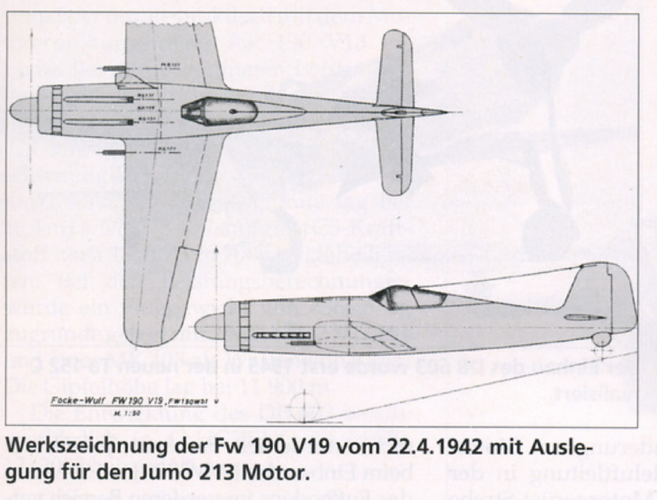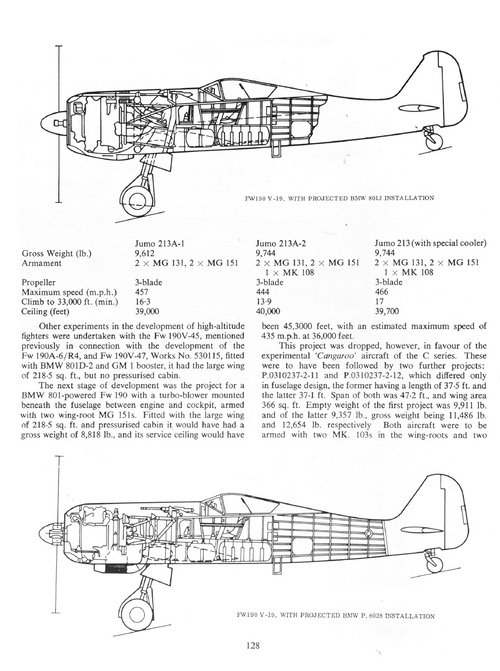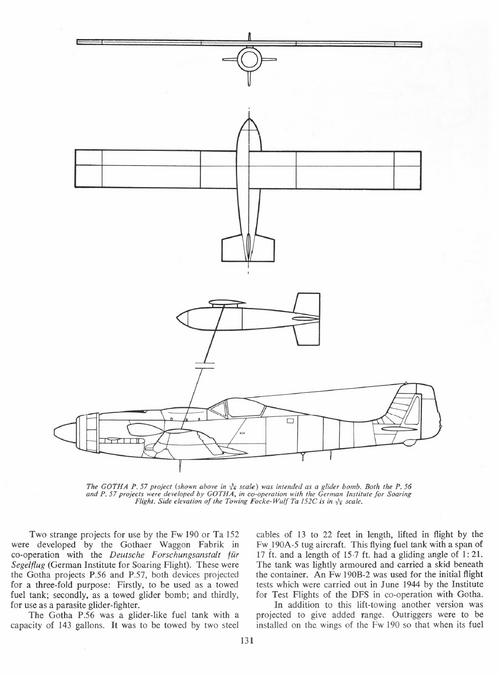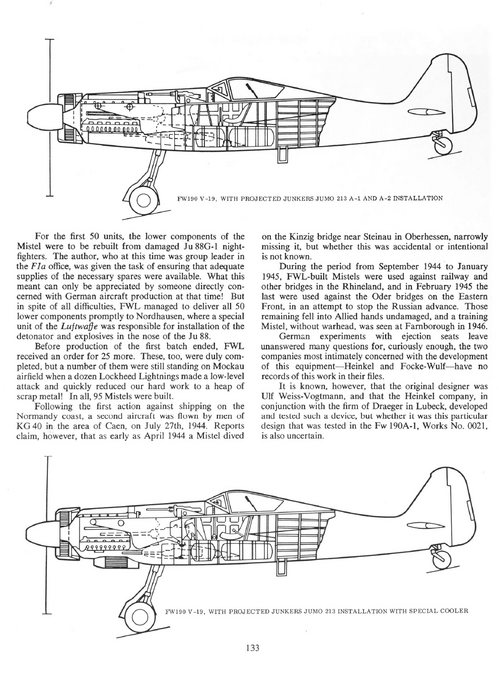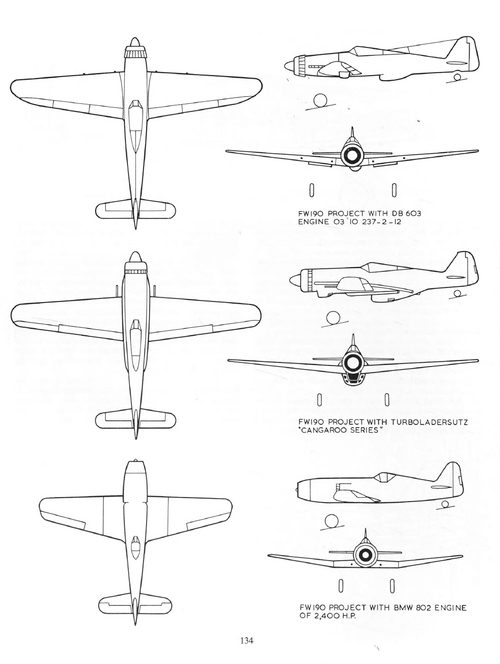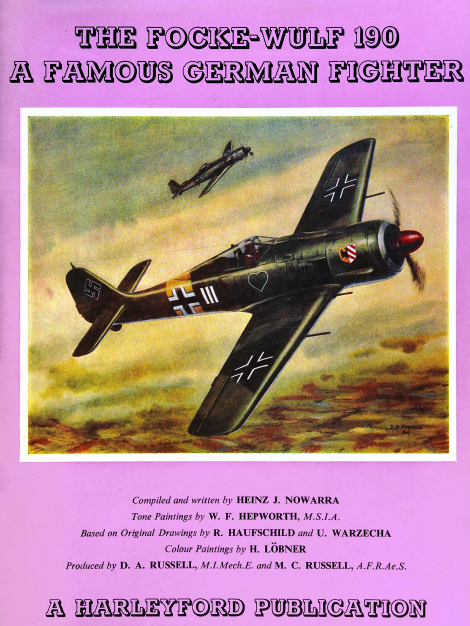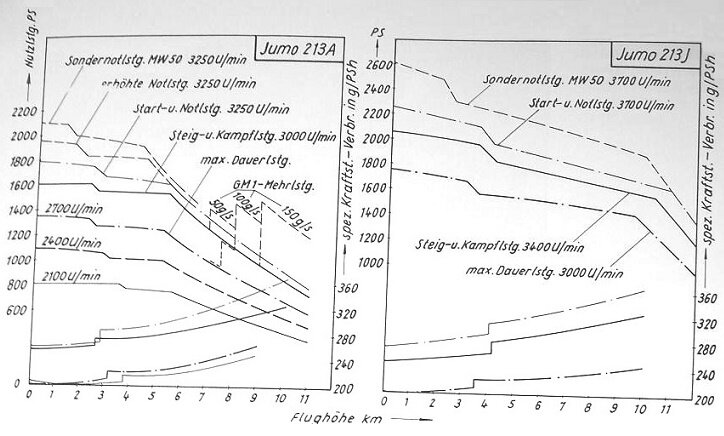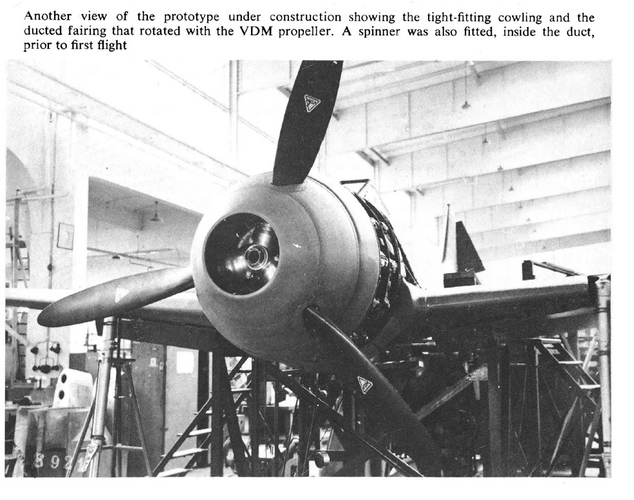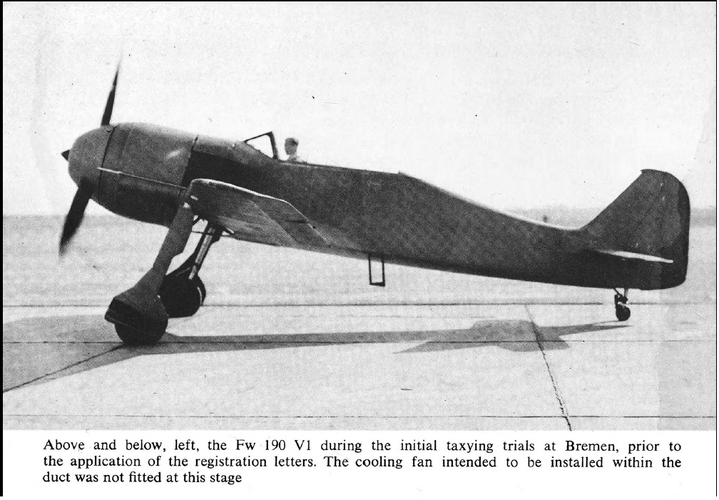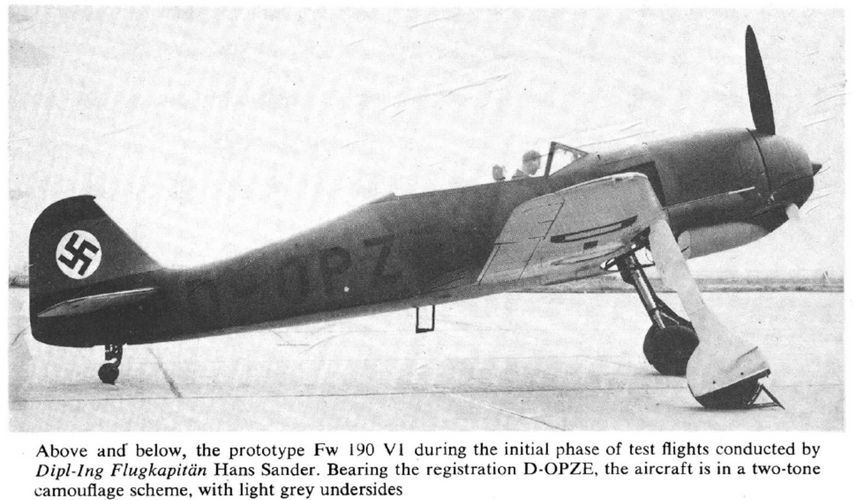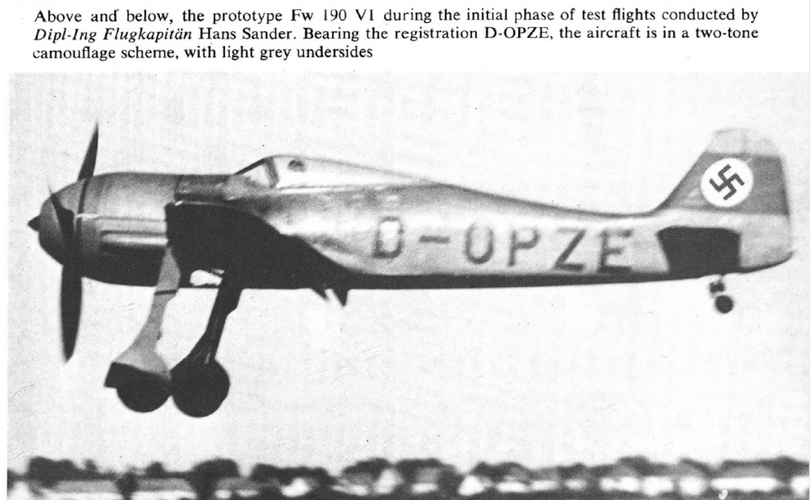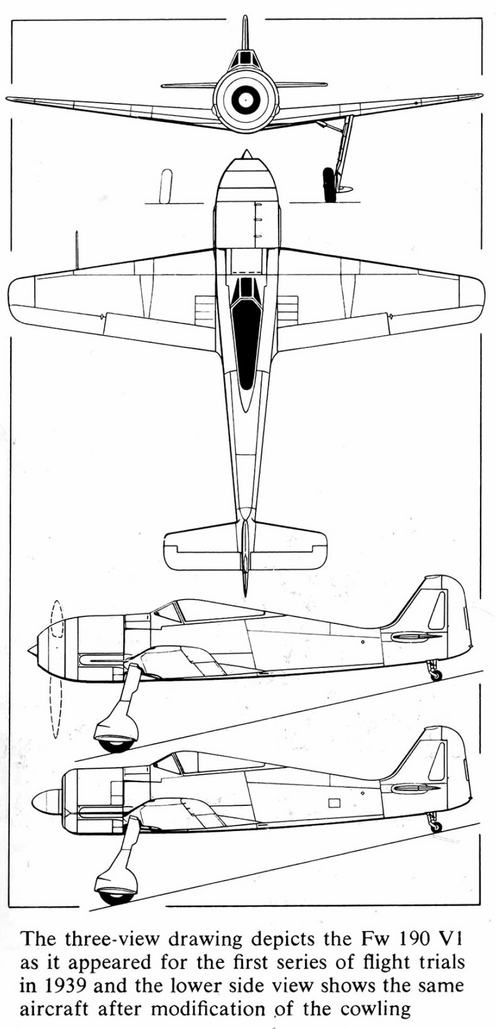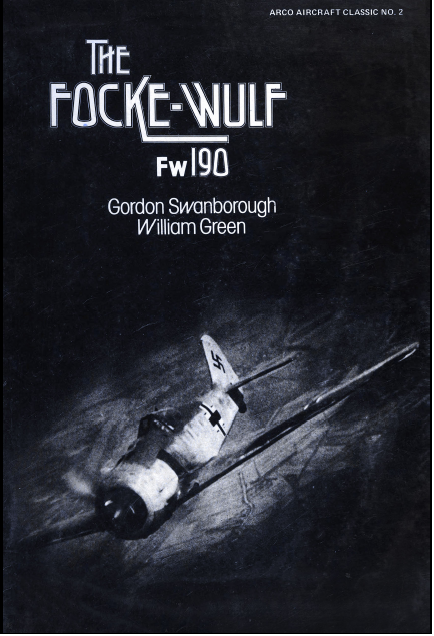Cheers, manHi Tomo,
I double-checked all seven issues of the German aviation magazine "Flugzeug Classic Extra - Focke Wulf Fw 190/Ta 152" regarding the Focke Wulf Fw 190F with the engine BMW 801 TF. Unfortunately, that article must be from a regular monthly issue of "Flugzeug Classic". Like HoHun, it would take me time going through each individual issue I have in my shelfs, either here in my office or in my basement.
During the following weekends, I might spend some time searching for that specific article.
You are using an out of date browser. It may not display this or other websites correctly.
You should upgrade or use an alternative browser.
You should upgrade or use an alternative browser.
Focke Wulf Fw 190 / Ta 152 Projects & Variants
- Thread starter Justo Miranda
- Start date
Hi again,
It's the 2007/09 issue.
Regards,
Henning (HoHun)
I'm sure the relevant issue is sitting right here on my bookshelf, but as Flugzeug Classic never published comprehensive table of contents, I have no way to find it except by going through each individual issue.
It's the 2007/09 issue.
Regards,
Henning (HoHun)
- Joined
- 3 June 2006
- Messages
- 3,092
- Reaction score
- 3,939
Hi @sienar, this screenshot is taken from Flugzeug Classic, page 33, issue 06-2007.v19 with a quite different wing
[...]
Is something known about this aircraft and its properties, flight characteristics et al?
Why wouldn't they have gone with this configuration? It looks like a Hayate from above.
Hi Spicmart,
The article in Flugzeug Classic 06/2007 explains that the wing was redesigned based on the A-2 to allow the installation of different engines. The wing was moved forward by 120 mm, with the landing gear geometry being changed so that the wheels are 220 mm forward of the original position.
As the caption in the above scan is not entirely legible: It's "Focke-Wulf FW 190 V19, FW 190WD1". No explanation what "WD1" might mean is provided.
(The armament captions are hard to decipher even in the original, but it looks like MG 151 in the wing root, MG 131 in the cowl, and an MK 108 as engine cannon to me.)
Basically, Focke-Wulf compared the Fw 190's performance as a defense fighter with the following engines:
- BMW 801C, BMW 801D, BMW 801J (turbo-supercharged 801), BMW P. 8028 (two-stage supercharged 801 with intercooler)
- DB 603, DB 614 (improved, high-altitude DB 603), DB 623 (turbo-charged DB 603)
- Jumo 213 A2, Jumo 213 "mit Vorstufe", Jumo 213 with intercooler
(It's not entirely clear to me what "mit Vorstufe" means ... as it's also called "axiale Vorstufe" in the text, maybe it's the swirl throttle?)
The DB 623 wouldn't have fit into the new airframe, but was included in the comparison anyway. The DB 609 and DB 624 (extreme high-altitude DB 603 with 15 km full throttle height) wouldn't have fit and were disregarded for the comparison.
The criterion for the performance was the maximum distance from the take-off point that the defense fighter could reach in 20 minutes, given a defined combat altitude. The combat altitudes considered were 6 km, 10 km and 11 km.
The DB 603-engined variant ranked first for 6 km and 10 km. If armament was reduced, it also ranked first for 11 km.
The DB 614-engined variant ranked fourth for 6 km, but second for 10 km and 11 km.
The Jumo 213 with pre-stage and the Jumo 213 A2 (with also had a pre-stage) ranked second and third for 6 km, and third and fourth for 10 km, but didn't make it to 11 km within 20 minutes. These engines apparently ran on C3 fuel, as the Jumo 213 A2 has an additional entry marked with "87 octane".
The DB 623 as extreme high-altitude engine was poor for 6 km and nothing special for 10 km, but ranked third for 11 km.
The BMW 801J was ranked fourth and last of the engines that reached 11 km, and took last place for 6 km and for 10 km as well. (Disregarding the poor old BMW 801C, which didn't make it to 10 km in 20 min).
All other engines did not make it to 11 km in 20 min either.
I would argue that the strong emphasis on climb performance probably was not really reflecting the performance requirements a fighter for the defense of the airspace over Germany would require, but as this comparison was done in April 1942, Focke-Wulf (and the RLM) probably didn't really have a realistic idea yet of what would be required in 1943 and 1944.
Regards,
Henning (HoHun)
Is something known about this aircraft and its properties, flight characteristics et al?
Why wouldn't they have gone with this configuration? It looks like a Hayate from above.
The article in Flugzeug Classic 06/2007 explains that the wing was redesigned based on the A-2 to allow the installation of different engines. The wing was moved forward by 120 mm, with the landing gear geometry being changed so that the wheels are 220 mm forward of the original position.
As the caption in the above scan is not entirely legible: It's "Focke-Wulf FW 190 V19, FW 190WD1". No explanation what "WD1" might mean is provided.
(The armament captions are hard to decipher even in the original, but it looks like MG 151 in the wing root, MG 131 in the cowl, and an MK 108 as engine cannon to me.)
Basically, Focke-Wulf compared the Fw 190's performance as a defense fighter with the following engines:
- BMW 801C, BMW 801D, BMW 801J (turbo-supercharged 801), BMW P. 8028 (two-stage supercharged 801 with intercooler)
- DB 603, DB 614 (improved, high-altitude DB 603), DB 623 (turbo-charged DB 603)
- Jumo 213 A2, Jumo 213 "mit Vorstufe", Jumo 213 with intercooler
(It's not entirely clear to me what "mit Vorstufe" means ... as it's also called "axiale Vorstufe" in the text, maybe it's the swirl throttle?)
The DB 623 wouldn't have fit into the new airframe, but was included in the comparison anyway. The DB 609 and DB 624 (extreme high-altitude DB 603 with 15 km full throttle height) wouldn't have fit and were disregarded for the comparison.
The criterion for the performance was the maximum distance from the take-off point that the defense fighter could reach in 20 minutes, given a defined combat altitude. The combat altitudes considered were 6 km, 10 km and 11 km.
The DB 603-engined variant ranked first for 6 km and 10 km. If armament was reduced, it also ranked first for 11 km.
The DB 614-engined variant ranked fourth for 6 km, but second for 10 km and 11 km.
The Jumo 213 with pre-stage and the Jumo 213 A2 (with also had a pre-stage) ranked second and third for 6 km, and third and fourth for 10 km, but didn't make it to 11 km within 20 minutes. These engines apparently ran on C3 fuel, as the Jumo 213 A2 has an additional entry marked with "87 octane".
The DB 623 as extreme high-altitude engine was poor for 6 km and nothing special for 10 km, but ranked third for 11 km.
The BMW 801J was ranked fourth and last of the engines that reached 11 km, and took last place for 6 km and for 10 km as well. (Disregarding the poor old BMW 801C, which didn't make it to 10 km in 20 min).
All other engines did not make it to 11 km in 20 min either.
I would argue that the strong emphasis on climb performance probably was not really reflecting the performance requirements a fighter for the defense of the airspace over Germany would require, but as this comparison was done in April 1942, Focke-Wulf (and the RLM) probably didn't really have a realistic idea yet of what would be required in 1943 and 1944.
Regards,
Henning (HoHun)
Airborne2001
ACCESS: Secret
- Joined
- 19 June 2020
- Messages
- 224
- Reaction score
- 277
The wing layout is giving me Japan vibes.
Dagger
ACCESS: Secret
- Joined
- 24 December 2019
- Messages
- 334
- Reaction score
- 620
I am not German but nevertheless I would expect that in Germany a swirl throttle would probably be called "verstellbare Leitschaufeln".(It's not entirely clear to me what "mit Vorstufe" means ... as it's also called "axiale Vorstufe" in the text, maybe it's the swirl throttle?)
"axiale Vorstufe" would in my mind refer to an "axial stage before" the supercharger impeller eye, maybe similar to a small diameter inducer upstream the impeller eye like some centrifugal pumps and centrifugal compressors nowadays have.
Maybe it is just another name for what is called "Vorsatzläufer" in this image:
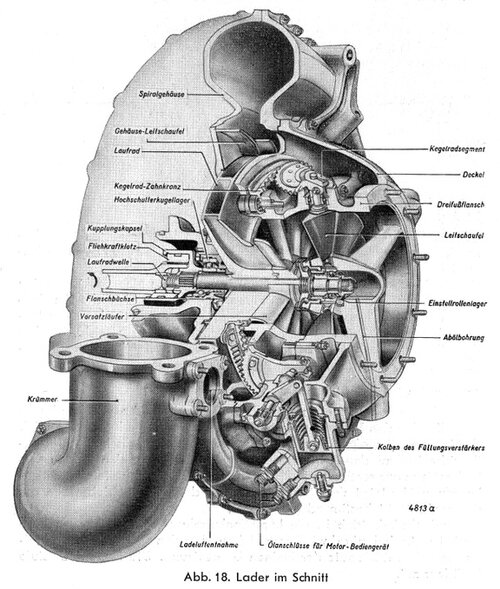
I am not German but nevertheless I would expect that in Germany a swirl throttle would probably be called "verstellbare Leitschaufeln".
I'd say that strictly speaking the "verstellbare Leitschaufeln" = 'adjustable guide vanes' are only components of the swirl throttle, which is called "Dralldrossel" ('spin throttle', as it imparts a spin on the throttled air mass), but basically, everything else than the vanes is of secondary importance for the swirl throttle's function
Maybe it is just another name for what is called "Vorsatzläufer" in this image:
That would seem like a possible explanation. Slightly odd that this would be considered an additional stage as I believe it's firmly bolted to the supercharger wheel, being a separate piece only for manufacturing reasons, but on the other hand, the Jumo engineers knew that their older supercharger wheels didn't have these vanes, so they might have had a different perspective.
If there was a point in the life of the Jumo 213A where it didn't have this Vorsatzläufer I'd say that would confirm your suggestion.
The Flugzeug Classic 06/2007 article mentions the following Jumo 213 variants:
"Jumo 213":
- single stage, without axial pre-stage, without intercooler, base engine for the Fw 190 V19 airframe
"Jumo 213 A-2":
- single stage, with axial pre-stage, without intercooler, base engine for the Fw 190 V19 airframe
"Jumo 213":
- two-stage with intercooler, base engine for the Fw 190 V19 airframe
The table with the comparison results then confuses matter a bit by listing the following engines:
1) "Jumo 213 with pre-stage" (which according to the list above would have to be the Jumo 213 A-2)
2) "Jumo 213 A 2" (which nominally actually *is* the Jumo 213 A-2, but gets different results from engine #1)
3) "Jumo 213 with intercooler" (which would be the two-stage engine)
4) "Jumo 213 A 2 (87 octane)", which probably is the same as engine #2 running on different fuel
Regards,
Henning (HoHun)
Scott Kenny
ACCESS: USAP
- Joined
- 15 May 2023
- Messages
- 11,279
- Reaction score
- 13,753
I must be misunderstanding something, because I didn't think 400m was particularly bad for a fighter's guns. Besides, they're getting set to converge at some distance, usually 100-200m in front of the plane.When the new MK 108 cannons of 30 mm were available, it was discovered that the weapon had gone prematurely in service with the Fw 190 A-7, A-8 and A-9 without being fully tested and that its effective range was limited to 400 m.
It'd be considered a separate stage in a jet engine, too. If designed correctly, you should get at least a 1.2x increase in pressure per axial stage and up to a 7x increase per centrifugal stage.That would seem like a possible explanation. Slightly odd that this would be considered an additional stage as I believe it's firmly bolted to the supercharger wheel, being a separate piece only for manufacturing reasons, but on the other hand, the Jumo engineers knew that their older supercharger wheels didn't have these vanes, so they might have had a different perspective.
Hi Scott,
Good point.
The USAAF officially considered 1200 ft (slightly less than 400m) the limit of effective range:

The manual also states:
Note that from the context provided elsewhere in the manual, this statement applies to the centreline mounted guns in the P-38, and the less rigid gun installations in fighters' wings combined with the convergence/divergence geometry reduces the bullet density even further.
USAAF pilots were aware of this effect - quoting Major Riemensnider (from "Combat Profile: Mustang" by Roger Freeman:
"Boots" Blesse wrote in his "No Guts, No Glory" ( http://www.simhq.com/_air/PDF/NGNG.pdf ) ...
The US report No. 727 of Ballistic Reserach Laboratory (part of the Aberdeen Proving Ground organization, I believe) provides details on a dataset for P-47 fighters engaging the Luftwaffe in 229 separate encounters during which 1053 bursts were fired, and the data shows that about 85% of the bursts were fired at less than 600 yards (550). That's probably an indication of how far optimistic fighter pilots were willing to stretch it ;-)
Regards,
Henning (HoHun)
I must be misunderstanding something, because I didn't think 400m was particularly bad for a fighter's guns. Besides, they're getting set to converge at some distance, usually 100-200m in front of the plane.
Good point.
The USAAF officially considered 1200 ft (slightly less than 400m) the limit of effective range:
Air Forces Manual No. 64 Fighter Gunnery Firing Rockets Dive Bombing 1 May 1945 : US Army Air Force : Free Download, Borrow, and Streaming : Internet Archive
World War 2 Air Force Manual for employment of guns, rockets and bombs. Includes Harmonization patterns.
archive.org
The manual also states:
"Various forces beyond your control act on the bullets and limit their effective range. THE CONE OF BULLET DISPERSION from a Cal. .50 fighter machine gun is about 4 mils for 75% of the rounds. Even with multiple guns, the lethal bullet density is unsatisfactory for air firing at ranges exceeding about 1000 ft."
Note that from the context provided elsewhere in the manual, this statement applies to the centreline mounted guns in the P-38, and the less rigid gun installations in fighters' wings combined with the convergence/divergence geometry reduces the bullet density even further.
USAAF pilots were aware of this effect - quoting Major Riemensnider (from "Combat Profile: Mustang" by Roger Freeman:
"I had previously flown the twin-engined P-38 Lightning where the nose-mounted armament made for an ideal gun platform. Ranging wasn't the problem it was with the P-51 and other fighters which had wing-mounted armament where the fire converged. It out outfit the guns were adjusted for a point of convergence 300 yd ahead where, theoretically, they gave an approximately 8 x 10ft bullet pattern. In practice, because of the speed of closure, it was not easy to achieve that exact range when you hit the gun trigger. So there was a tendency for pilots to open fire at a target further off and hold a long burst as they closed. If you got in a correctly ranged burst, it was highly destructive."
"Boots" Blesse wrote in his "No Guts, No Glory" ( http://www.simhq.com/_air/PDF/NGNG.pdf ) ...
"Contrary to much that has been published, the Fighter Pilots who shot down more than an occasional Mig or two, got them around 400 - 1200 feet just like they did in Europe and the Sourthwest Pacific during Word War II."
The US report No. 727 of Ballistic Reserach Laboratory (part of the Aberdeen Proving Ground organization, I believe) provides details on a dataset for P-47 fighters engaging the Luftwaffe in 229 separate encounters during which 1053 bursts were fired, and the data shows that about 85% of the bursts were fired at less than 600 yards (550). That's probably an indication of how far optimistic fighter pilots were willing to stretch it ;-)
Regards,
Henning (HoHun)
- Joined
- 26 May 2006
- Messages
- 34,781
- Reaction score
- 15,659
Airborne2001
ACCESS: Secret
- Joined
- 19 June 2020
- Messages
- 224
- Reaction score
- 277
View: https://www.instagram.com/p/Cr_Ar_jubgw/?igsh=MWxwdnZydnA2eTZ6OQ==
Can anyone please confirm the existence of a Jumo 213I that could produce 2,700HP, and that it was intended for the Ta-152H by November? I am aware of the Jumo 213EB and its planned installation by July 1945, but this other development is new to me.
Can anyone please confirm the existence of a Jumo 213I that could produce 2,700HP, and that it was intended for the Ta-152H by November? I am aware of the Jumo 213EB and its planned installation by July 1945, but this other development is new to me.
That should probably be Jumo 213J, not 213I - a typo, IMO.Can anyone please confirm the existence of a Jumo 213I that could produce 2,700HP, and that it was intended for the Ta-152H by November?
Airborne2001
ACCESS: Secret
- Joined
- 19 June 2020
- Messages
- 224
- Reaction score
- 277
That should probably be Jumo 213J, not 213I - a typo, IMO.
Was the 213J only 2,400HP though? This higher figure is new to me. (Unless I have not read the best sources as of yet.)worldwar2jets copied that line from Dietmar Hermann's Ta 152 book from 1999.
Dietmar also mentions it in his Ta 152 H article in Flugzeug Classic of April 2010.
Typo would then be by Dietmar.
Dagger
ACCESS: Secret
- Joined
- 24 December 2019
- Messages
- 334
- Reaction score
- 620
Airborne2001
ACCESS: Secret
- Joined
- 19 June 2020
- Messages
- 224
- Reaction score
- 277
So an unknown development for late 1945 perhaps? Interesting.Dietmar Hermann mentions a Jumo 213 I that was supposed to be introduced in service in November 1945 with 2700 hp take-off power (Startleistung) and 1900 hp at 10,000 meters. Not clear where he got that info.
The Jumo 213 J would have a lower power than that:
View attachment 722906
Hi,
It's an old German typographic convention that capital "I" letters are type-set as capital "J" letters. As far as I know, during WW2 there was never a distinction between I and J versions in terms of aviation equipment or aircraft, even if in different typographical contexts a capital "I" might have been used.
(Probably the best-known example from an aviation context is WW1's heavily armoured Junkers J.I, where the "J" designation stood for "Infanterieflieger" = 'Infantry Aircraft'.)
So, I would suspect that both the I and J designations refer to the same basic engine type, regardless of different reported performance and capabilities. Especially late in the war, there was a lot of hectic redefining of project goals going on.
Regards,
Henning (HoHun)
Dietmar Hermann mentions a Jumo 213 I that was supposed to be introduced in service in November 1945 with 2700 hp take-off power (Startleistung) and 1900 hp at 10,000 meters. Not clear where he got that info.
The Jumo 213 J would have a lower power than that
It's an old German typographic convention that capital "I" letters are type-set as capital "J" letters. As far as I know, during WW2 there was never a distinction between I and J versions in terms of aviation equipment or aircraft, even if in different typographical contexts a capital "I" might have been used.
(Probably the best-known example from an aviation context is WW1's heavily armoured Junkers J.I, where the "J" designation stood for "Infanterieflieger" = 'Infantry Aircraft'.)
So, I would suspect that both the I and J designations refer to the same basic engine type, regardless of different reported performance and capabilities. Especially late in the war, there was a lot of hectic redefining of project goals going on.
Regards,
Henning (HoHun)
Dagger
ACCESS: Secret
- Joined
- 24 December 2019
- Messages
- 334
- Reaction score
- 620
It seems you are right.......
So, I would suspect that both the I and J designations refer to the same basic engine type, regardless of different reported performance and capabilities. Especially late in the war, there was a lot of hectic redefining of project goals going on.
ln another Flugzeug Classic article from Sept 2006 about the Ta 152 Dietmar Hermann quotes the same data as above while referring to the Jumo 213 J
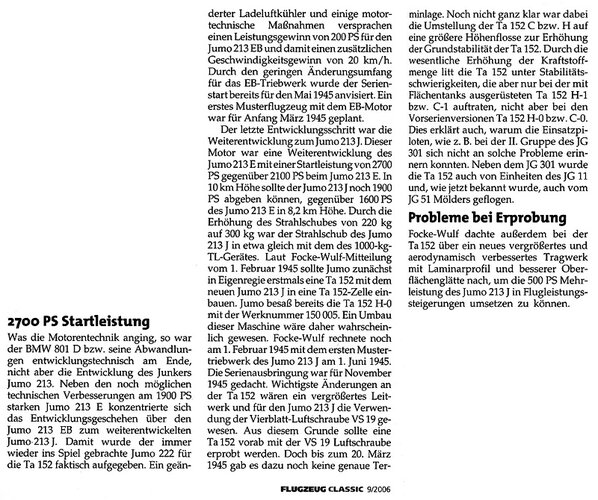
It seems you are right.
ln another Flugzeug Classic article from Sept 2006 about the Ta 152 Dietmar Hermann quotes the same data as above while referring to the Jumo 213 J
View attachment 723003
Especially interesting is the mentioned additioinal exhaust thrust of 300 kg (660 pounds) at 10.000 meters which would be the same as the Jumo 004 or BMW 003 at this height.
Was the 213J only 2,400HP though? This higher figure is new to me. (Unless I have not read the best sources as of yet.)
Calum Douglas once gave a figure as high as 2900 PS with MW50 and B4 for the Jumo 213J.
It could get comparably the most power out of mediocre-quality fuel.
Scott Kenny
ACCESS: USAP
- Joined
- 15 May 2023
- Messages
- 11,279
- Reaction score
- 13,753
Ah, that's cheating a bit. Water injection (to cool the intake charge via evaporative cooling) and Nitrous Oxide (to add more oxygen and cool the intake charge even more) let you run more boost than the fuel can support without detonation.Calum Douglas once gave a figure as high as 2900 PS with MW50 and B4 for the Jumo 213J.
It could get comparably the most power out of mediocre-quality fuel.
Airborne2001
ACCESS: Secret
- Joined
- 19 June 2020
- Messages
- 224
- Reaction score
- 277
On the topic of the Jumo 213J, can anyone confirm the existence of a Ta-152B-7 that was intended to use this as its powerplant? I've only seen airwar.ru mention the existence of such a variant.
Calum should know when he says the Jumo 213J was the most advanced engine of the war.Ah, that's cheating a bit. Water injection (to cool the intake charge via evaporative cooling) and Nitrous Oxide (to add more oxygen and cool the intake charge even more) let you run more boost than the fuel can support without detonation.
Scott Kenny
ACCESS: USAP
- Joined
- 15 May 2023
- Messages
- 11,279
- Reaction score
- 13,753
Not arguing that they didn't make the power, just that they cheated to get there.Calum should know when he says the Jumo 213J was the most advanced engine of the war.
- Joined
- 26 May 2006
- Messages
- 34,781
- Reaction score
- 15,659
- Joined
- 3 June 2006
- Messages
- 3,092
- Reaction score
- 3,939
Hi folks,Hi folks,
I highly recommend all German understanding members the newest issue, now part seven, of the German bookazine "Flugzeug Classic Extra - Focke-Wulf Fw 190", which has interesting articles and pictures about unbuilt projects and prototypes of the Focke-Wulf Fw 190 D-9 to D-15. B)
[...]
I highly recommend all German understanding members the newest issue, part eight and the final part of this German bookazine series.
It will be about the Focke-Wulf Ta 152 and its versions Ta 152 A/B, C, E and H.
For example, on page 31 are three new pictures of the prototype Ta 152 C V7 published.
The drawings are this time from the artists Asen Atanasow and Stefan Draminski.
Here the content:
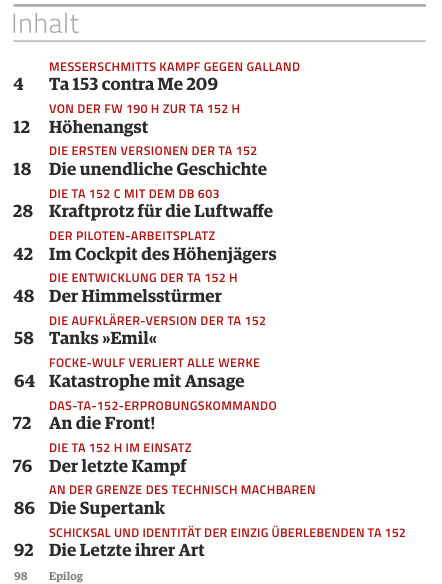
Links:Produktinformationen "Focke Wulf Ta 152"
Mit diesem achten und letzten Teil unserer großen Reihe über die Fw 190 erzählt Dietmar Hermann die ganze Geschichte der Ta 152. Hierbei lassen wir vor allem die ehemaligen Ta-Piloten zu Wort kommen: Wie hat sich die Ta 152 tatsächlich geschlagen? Und warum war sie allen anderen Jägern teils deutlich überlegen?
Flugzeug Classic Abo: Jetzt Wunschabo auswählen
Verlagshaus 24 - GeraMond
Last edited:
"if I were to design an aero engine now,
I`d pretty much scale down a 213J and maybe just opt for a Merlin 2-piece block sandwiched liner attachment.."
This is a quote from Calum Douglas on another forum.
My question is if it would have been possible/feasible to make a smaller version of the Jumo 213J, the size and weight of a DB 605?
I`d pretty much scale down a 213J and maybe just opt for a Merlin 2-piece block sandwiched liner attachment.."
This is a quote from Calum Douglas on another forum.
My question is if it would have been possible/feasible to make a smaller version of the Jumo 213J, the size and weight of a DB 605?
flitzer flash
ACCESS: Restricted
- Joined
- 24 December 2023
- Messages
- 14
- Reaction score
- 8
i know this is 2 months old but your comment seems to me to be eitherNot arguing that they didn't make the power, just that they cheated to get there.
1- very ignorant of WW2 Aero engines
0r
2- biased against Germans ( the constant propaganda for almost 80 years does that... " tell a lie tell it enough and it becomes accepted fact"( NOT GOEBBLES BTW who said the EXACT OPPOSITE in fact*) describes everyones "facts" of WW2 Germany but anyways
the americans, british french italians japanese and russians ALSO "CHEATED" TO GT THEIR FIGURES... NOW from experience ive discovered that most US and british engine outputs are exaggerated by at least 10%
but ALL nations cheated to get power outputs in WW2 BUT i wouldnt really refer to superchargers/ turbochargers or water methanol or nitros as "cheating" what is this the damn NHRA or NASCAR? its war there are no rules thus you cant cheat
* quote originates from the jewish nephew of sigmund freud a edward bernays. Goebbles never uttered such nonense nor did any NS official
- Joined
- 25 July 2007
- Messages
- 4,297
- Reaction score
- 4,183
* quote originates from the jewish nephew of sigmund freud a edward bernays. Goebbles never uttered such nonense nor did any NS official
How did we get from superchargers to defending the honour of Joseph Goebbels, et al?
But, since we're supposedly here in the defense of accurately-quoted sources, Edward Bernays wasn't the origin of that phrase either. If Bernays ever uttered anything similar, he was paraphrasing from a book published 22 years before he was born.
The original version came from dialogue in The Crown of a Life - a 1869 novel written by Robert Browning's friend, Isabella Blagden (as 'Isa' Blagden).
If a lie is only printed often enough, it becomes a quasi-truth, and if such a truth is repeated often enough, it becomes an article of belief, a dogma, and men will die for it.
You will also see this passage attributed to the similarly-titled The Crown of a Life by George Gissing - back that wasn't published until 1890. Further misattributions proliferated in the 20th Century.
With that out of the way, might we return to Fw 190 and Ta 152 airframe projects?
Last edited:
- Joined
- 11 March 2006
- Messages
- 8,618
- Reaction score
- 3,759
.. and apart from the fact, that Apophenia told us about the correct source of this quote, I really don't know, how to pin down the additional information, that Edward Bernays was the jewish nephew of Sigmund Freud ...
Perhaps a look at point 3 of the forum rules ("Political, religious and nationalistic topics are strongly discouraged") is helpful here, as not even for this a bit OT sidenote in the discussion, I can see any relevance of his religion.
Perhaps a look at point 3 of the forum rules ("Political, religious and nationalistic topics are strongly discouraged") is helpful here, as not even for this a bit OT sidenote in the discussion, I can see any relevance of his religion.
Last edited:
Ivan Culjak
ACCESS: Confidential
- Joined
- 11 September 2021
- Messages
- 53
- Reaction score
- 53
Cheating all the way the road, just like supercharging, adding more air, pfuiiAh, that's cheating a bit. Water injection (to cool the intake charge via evaporative cooling) and Nitrous Oxide (to add more oxygen and cool the intake charge even more) let you run more boost than the fuel can support without detonation.
Scott Kenny
ACCESS: USAP
- Joined
- 15 May 2023
- Messages
- 11,279
- Reaction score
- 13,753
As opposed to not running crap fuel that's 87 octane at best and running either more compression and/or more boost.Cheating all the way the road, just like supercharging, adding more air, pfuii
Having to use anti-detonation injection or nitrous oxide is cheating because as soon as you run out of either ADI or NOS you lose a massive amount of power.
Using 115/145 octane avgas and 15-20psi boost is 24/7 power.
- Joined
- 8 March 2009
- Messages
- 1,048
- Reaction score
- 1,275
Are they really exaggerated by 10% or are you forgetting about accessories....the americans, british french italians japanese and russians ALSO "CHEATED" TO GT THEIR FIGURES... NOW from experience ive discovered that most US and british engine outputs are exaggerated by at least 10%
What is the historical explanation of Kurt Tank being allowed by RLM to use his own initials in the Focke-Wulf Ta. 152 designation? Of course this is a case where the chief designer was not the founder/owner of the company producing his designs, contrary to Ernst Heinkel for instance, but in other similar cases the manufacturer's name prevailed in both the long and short designation, even when the technical director was well known and his influence unmistakenable: for instance Blohm&Voss BV. 238, not "Blohm&Voss Vo. 238", despite the fame already acquired by Richard Vogt.
Last edited:
Dagger
ACCESS: Secret
- Joined
- 24 December 2019
- Messages
- 334
- Reaction score
- 620
What is the historical explanation of Kurt Tank being allowed by RLM to use his own initials in the Focke-Wulf Ta. 152 designation?
This is what Thomas Hitchcock wrote in his Ta 152 book:
The “Ta” Prefix Emerges
In September 1942, at the behest of the Air Ministry, Focke-Wulf commenced preliminary design of a two-seat
night and bad weather fighter constructed largely of wood.
By this time, Kurt Tank (with the departure of Heinrich Focke in 1938) became Focke-Wulf 's chief executive officer and technical director.
In this capacity, Tank formally petitioned the Air Ministry to authorize that henceforth all Focke-Wulf creations should automatically carry the prefix “Ta” instead of “Fw".
Largely because of his esteemed reputation his request was readily granted.

